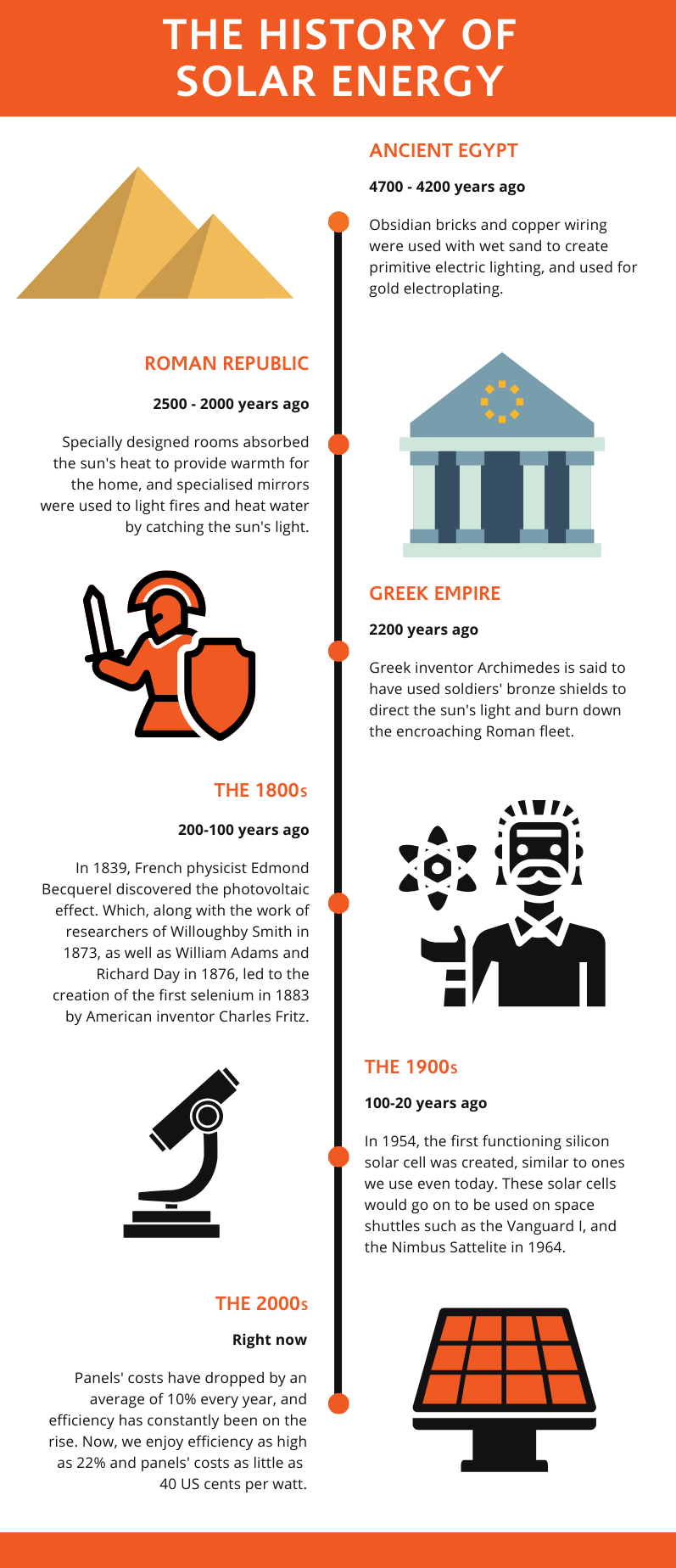
Solar is the word on so many people’s lips now. Renewables are the way of the future, and, with solar energy becoming more affordable, adaptable and powerful every day, that future is closer than ever!
However, mankind’s history has been intertwined with the power of the sun since ancient times, and solar energy as we know it today has been around in some form or another far, far longer than you might have thought. Check out the infographic below for the overview, but read on for the full story.

Ancient Times
Most recently, and most excitingly, we have discovered that the old kingdom of Egypt, who ruled as far back as 4,706 years ago, had basic solar cells. That is 600 years before the wheel! That’s right, humanity has been making use of solar power since before we mastered the wheel. These solar cells were created with boron rich obsidian stones, with inlaid copper wiring, and phosphorous infusions.
Originally, we thought these were used exclusively for electroplating of jewellery and ceremonial masks. However, recent discoveries point to the Egyptians having discovered a very early form of electric lighting with these simple panels and been able to use the pyramids as a form of energy generators, by storing these solar cells at the top of the pyramids to draw in solar energy at their apex over the course of the day, to provide lighting to temples and important locations over the night.
While this is certainly the most exciting and revolutionary example of ancient solar technology, it is hardly the only one. After all, humanity has worshipped the sun since time immemorial, and our fascination with it has been ever-present.
The Egyptians, alongside the Romans, made use of the sun in the design of their buildings, with clever room design and placement of mirrors being used to warm homes throughout the day, light fires (there is a reason they were known as ‘burning mirrors’) and even heat the water of bathhouses.
In the third century, the Greeks put these ideas to far greater effect when the Roman navy invaded the city of Syracuse. The legend goes that the inventor Archimedes had their stationed soldiers use their bronze shield en masse as a gigantic mirror, to turn the energy of the sun into something close to a laser beam, which they used to set fire to the approaching fleet. This may seem far-flung, but Greece’s navy tested this theory in the 1970s and did manage to set a wooden vessel alight from 50 metres away with only metal shields.
However, though the ancient Egyptians had inklings of what solar would become, solar energy as we know it did not emerge for thousands of years.
The 1800s
The earliest known researcher of solar energy as we understand it today was the French physicist Edmond Becquerel, who discovered the photovoltaic effect in 1839 when experimenting with metal electrode cells in a conducting solution, giving us the very first hint of what was to come when he noted that the cell produced more electricity when exposed to sunlight.
Then, in 1873, English electrical engineer Willoughby Smith discovered that the chemical element Selenium could be used as a photoconductor. With this established, researchers William Grylls Adams and Richard Evans Day put Becquerel and Smith’s research together in 1876 when they recorded that it would generate electricity when exposed to sunlight.
In 1883, 50 years after the initial discovery - a lifetime for some in those days, American Inventor Charles Fritz would create the first working selenium solar cell. Though we would later transition to using silicon in its place, this was an important step in the development of modern solar energy.
The 1900s and 2000s
It is perhaps unsurprising that Albert Einstein would be one of the first to truly remark on how powerful solar energy would become. In 1905, he published a paper discussing how light carries energy and how this could be utilised, which led to a growth of interest in solar energy and power.
But the greatest developments in solar would not come until the 1950s and onwards. Daryl Chapin, Calvin Fuller and Gerald Pearson created the first fully functioning silicon solar cell in 1954, and designs similar to theirs would later be used throughout the ’50s and ’60s on spacecraft such as the Vanguard I in 1958 and the Nimbus satellite in 1964, which operated purely on a solar array.
Though solar was entering the public eye and becoming more and more accepted as a source of energy, it wouldn’t be until the late 90s and 2000s that solar began to become commonplace around the home. This is due to the low-efficiency panels exhibited early on; however, both panels’ efficiency and cost rapidly began to improve from the 1980s onwards, with panels’ cost dropping an average of 10 percent per year ever since the ‘80s.
Now, solar is at the height of its power and is having its time in the sun. With panels enjoying efficiency levels of well over 22% (compared to below 10% during their initial employment in spacecraft) and prices average $0.40 USD per watt, solar is one of - if not the most - affordable energy option to invest in for our future.
But it couldn’t have got there without all the history backing it, from the ancient Egyptian clergy to the Roman architects and Greek inventors, all the way to French physicists and American inventors. A thousand tiny steps and great leaps have carried us this far down the road, and, with solar always improving, it doesn’t seem we’ll stop running down it any time soon.




